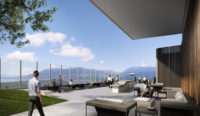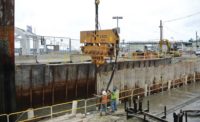In the Shadow of the Olympics, Vancouver Rebuilds Key Road
A massive highway renovation is unfolding only minutes away from Vancouver’s Winter Olympics, and the centerpiece will be a new cable-stayed bridge crossing the Fraser River from Surrey to Coquitlam.

At 1.2 miles in length including approaches, the bridge will be one of the longest of its kind in North America.
Part of a 22.9-mi, $2.33-billion overhaul of Highway 1, the principal corridor in the greater Vancouver area, the project is designed to ease congestion, especially on the existing Port Mann Bridge. Financing will be paid down with tolls. When done, the new structure will provide an upgrade for a very busy portion of the river.
The principal contractor is working through a mass of technical issues, says Jeff Ellis, deputy project director for a joint venture of Omaha-based Peter Kiewit Sons Inc. and Longmont, Colo.-based Flatiron Construction Corp. A spokesman for the company created by Vancouver to build the bridge, Transportation Investment Corp. (TIC), says its contract with the joint venture contains incentives and penalties but declined to give details. Under the design-build contract the bridge could be ready by 2012.
Original plans called for twinning the current bridge, but a spokeswoman for TIC says it was soon discovered retrofitting and maintenance costs would be $190 million more than simply building a new bridge. The old bridge will be torn down at the end of the project.
The new version will become what is believed to be the widest cable-stayed bridge in North America, with a driving width of 164 ft and a total width of 213 ft. Two unconnected decks carrying lanes in each direction.
There is also a 10-ft-wide multi-use path on one side, finally connecting Surrey to the rest of the metro Vancouver’s intricate biking system. (Vancouver has the highest per capita rate in North America of commuters biking to work.)
As part of the design, the cable-stayed structure will have two towers 1,541 ft apart. The south tower is being placed on land near a railyard, and the north tower is in the Fraser River, adjacent to the main navigation channel.
On the bridge’s main span, two different types of segmental construction will be used—balanced cantilever and span-by-span—to keep as much construction out of the water as possible.
The geotechnical conditions are less than ideal, with a blend of soft ground, compressible soils and liquefiable sands, Ellis says. The support of the bridge deck includes concrete pylons and steel piers. The cast-in-place concrete pylons, from the top of the footing to the top of the pylon, are 525 ft.
The bridge will also have 251 drilled steel piles about 6 ft in diameter ranging from 131 ft to 278 ft in depth. Support shafts also will help stabilize the bridge in the soft ground along the river.







